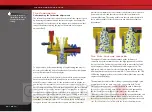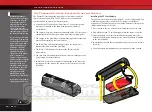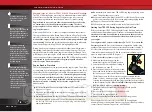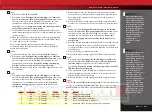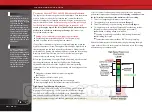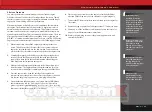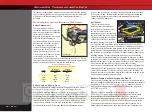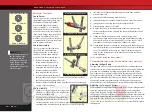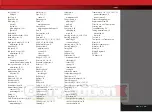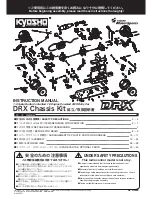
Toe In
3
1
3
1
Configuration
Stock
Raised
Lowered
Long travel
Available
Camber
(degrees)
+3 to -5
+3 to -1
+3 to -5
+3 to -1
Available Toe
(degrees)
Toe Out
3
1
3
1
Maximum Alignment Limits (using stock push rod length)
Revo’s maximum toe and camber alignment settings can be limited by
the ride height setting. Do not exceed the maximum limits or you could
experience interference between suspension components. The ride
height is controlled by where the push rod is installed in the lower
suspension arm. First determine which of the following configurations
you are using:
a. Stock Configuration
– When the pushrod is in the middle position of the
lower control arm.
b. Raised Configuration
- When the pushrod is in the raised position to
increase the vehicle’s ride height (innermost hole in lower control arm).
c. Lowered Configuration
- When the pushrod is in the lowered
position to decrease the vehicle’s ride height (outermost hole in
lower control arm).
d. Long Travel Configuration
– When the pushrod is in the middle
position of the lower control arm with the Long Travel rockers installed.
Front Suspension
The following are suggested maximum settings for the front suspension
in order to avoid interference between suspension components:
Rear Suspension
The following are suggested maximum settings for the rear suspension
for all configurations. Toe out is not normally used on the rear of Revo.
Transmission Tuning
Adjusting the Slipper Clutch
Your Revo is equipped with an
adjustable Torque Control slipper
clutch. The slipper clutch is integrated
into the main spur gear on the
transmission (see page 6). The slipper
clutch is adjusted by loosening the
spring-loaded locknut on the slipper
shaft. Use the supplied 8mm open-end
metric wrench. To tighten or loosen the
slipper nut, insert the 2.0mm hex wrench into the hole in the end of the
slipper shaft. This locks the shaft for adjustments. Turn the adjustment
nut clockwise to tighten (less slippage) and counter-clockwise to loosen
(more slippage). The slipper clutch has two functions:
1.
Limiting the engine’s torque output to the wheels to prevent
wheelspin on low traction surfaces and uncontrolled wheelies on
high traction surfaces.
2.
Protecting the drivetrain from sudden impact or shock loads (such as
landing from a jump with the engine at full throttle).
From the factory the slipper clutch is set for minimal slippage, just
enough to protect the drivetrain from shock loads. On slippery, low
traction surfaces such as a hard-packed, dry racetrack you may benefit
from loosening the slipper adjustment nut to allow for more clutch
slippage. This will make the truck easier and more forgiving to drive by
helping to reduce the amount of wheel spin. Loosening the slipper
adjustment can also improve performance on extreme high traction
surfaces by preventing the front end from lifting off of the ground when
accelerating. Make slipper adjustments in small 1/8 turn increments.
The maximum tight setting for the slipper is just at the point where
there is little or no tire slippage on a high traction surface such as carpet
or a prepared racetrack. The slipper should not be tightened to the point
that clutch slippage is completely eliminated. Do not overtighten the
slipper nut or you could damage the slipper bearings, pressure plates, or
other components.
Revo • 37
Basic Tuning Adjustments
Toe In
3
Configuration
All
Available
Camber
(degrees)
+3 to -5
Available Toe
(degrees)
Toe Out
2


